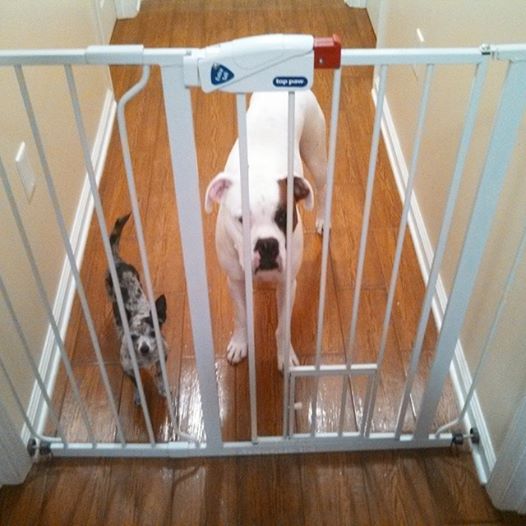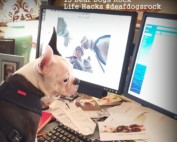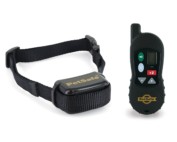Since I use “time out” training on my deaf dog Bud sometimes, I thought this would be some good training information for some of you who have “bossy” dogs or dogs that like to get into everything (including counter surfers). This training also works with mild resource guarding (If you have a Boston Terrier you will understand). With my deaf dog Bud I use this method of training because sometimes he can be very bossy with my boxer puppy Axl. I found that Bud just needed basic redirection from a over stimulus situation (like when the UPS truck pulls up). We never want to use your deaf dog’s crate for “time out”. We don’t want the dog to think of his crate as punishment ever. We want only good things to happen in their crates and since we worked so hard on positive reinforcement crate training, I am very careful not to undo my crate training success. My dogs get new treats, toys and sometimes meals in their crates and they love their crates. It is better to have a neutral area that keeps the entire experience positive.
I set up a “time out” area for him in our hallway. I purchased a short dog gate and a tall dog gate (the tall gate can be purchased at Petsmart and it is made by Top Paw. The short gate is made by Regalo). This way if both of my deaf dogs are misbehaving one can go into the “time out” area in the back of the hallway and the other can go to a “time out” area in the front of the hallway. Sometimes they work as a team with one of them being the look out while the other takes the trash out of the trash can.
If they get to ramped up when they are playing I usually will use a “time out” to redirect them. It doesn’t have to be a negative experience. I start by teaching the “time out” sign by giving the sign and then taking the dog back into the time out area and they get a treat. Repeat often. Once they get the “time out” sign down practice giving it and sometimes they get a reward and sometimes they don’t. When the UPS guy comes and both dogs are freaking out (I worry that they might redirect their excitement/arousal on each other so I will give Axl the “time out” sign and he will race back to the time out area. He only has to be there for a minute or two and if he is sitting and not barking he gets to come back out. This is a great way to redirect your dog and also interrupt an unwanted behavior.
I also installed a gate at the top of our stairs case leading to our guest rooms so they can’t run down stairs and get into things without me seeing them. It is important to have your deaf dogs within your sight (at least for me it is very important). The gate at the top of the stairs is also a “stay out” zone so when we have guests they can relax down stairs away from our SIX dogs and this gate also keeps our dogs from getting into their suit cases and go through all of their stuff.
Both of my boxers know the sign for “time out” which is the same “time out” sign a referee would use when refereeing a game in sports. We only do very short “time out” sessions like 30-45 seconds and then give the dog another chance to correct the behavior. If your dog gets to rough in his play group and you put your dog in time out for say 30 seconds, make sure you put your dog right back into the play group to see if he corrects his behavior.
Lately we have used it on Bowie when he acts out when he is resource guarding when I am giving out treats. They all have to sit and wait to each get a treat (they are fed separately in their crates) and sometimes Bowie will snarl at my 6 pound Chihuahua Pepe and if he does he gets put into time out for like 60 seconds. When he is sitting and not barking he gets to come back out. Every time he comes back out he runs up to Pepe to kiss him all over as if to say I am sorry. By doing this often and repeating this action your dog will connect the time out area with his/her previous actions.
Happy training! ~ Christina Lee – Deaf Dogs Rock
Here is some great advice via the www.aspca.org website about “time out” training.
When Should I Use Time-Outs?
The “time-out” is a useful tool for eliminating many unwanted behaviors in dogs. Repeatedly interrupting an unwanted behavior and immediately giving your dog some time alone can rapidly decrease the frequency of that behavior. Time-outs are especially effective in discouraging the following common problems:
Harassment of another pet (chasing the cat, playing too roughly with another dog, etc.)
Attention-seeking behaviors, like barking, pawing, whining or mouthing
Jumping up, mouthing and rowdy behavior when greeting visitors
Mouthing clothes, hands or feet during play
Begging during mealtimes
It may take some time and effort, but if you consistently deliver time-outs when your dog does something you don’t like, he’ll soon decide that the activity isn’t much fun after all!
How Do I Use Time-Outs?
The Technique
Here’s an example of how to use time-outs to teach your dog to stop putting his paws on the table while you’re eating.
If possible, prepare a time-out room in advance. Choose a safe, small space, like a bathroom or a laundry room. Make sure that the area is free of toys and things your dog might destroy.
When you’re home and can supervise, keep a lightweight leash clipped to your dog’s collar, and let him drag it around.
The instant your dog’s paws touch the table, say “Too bad!” (or in this case sign to your deaf dog “NO” and then give the “TIMEOUT” sign). Then immediately pick up the leash and march him to the time-out room. (If you don’t have a small room to use or think that your dog might have fun in his time-out area, shut the leash in the door to limit his movement.)
Wait 10 to 30 seconds. Then, if your dog isn’t barking, let him out of the room and pretend that nothing happened. If he does bark while in time-out, wait for him to stop.
If your dog puts his paws on the table again, march him right back to time-out. Repeat as many times as necessary. If your dog does not jump up on the table, seize the opportunity to reinforce his good behavior. He’s starting to understand what you’re trying to teach him! Let him know how clever he is by giving him plenty of praise, petting or a treat.
Click here to find out more from the aspca.com about why the “time out” timing is so inportant.









